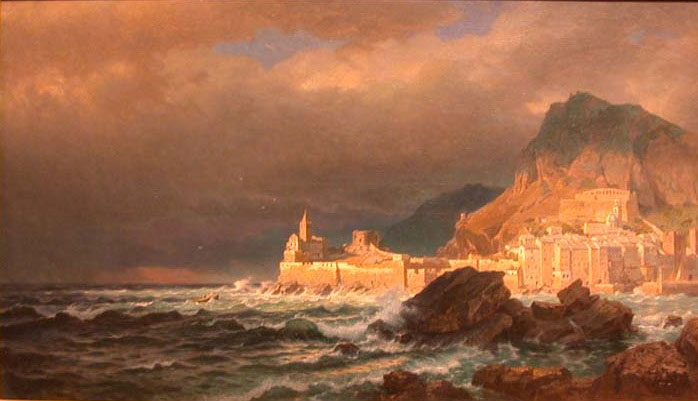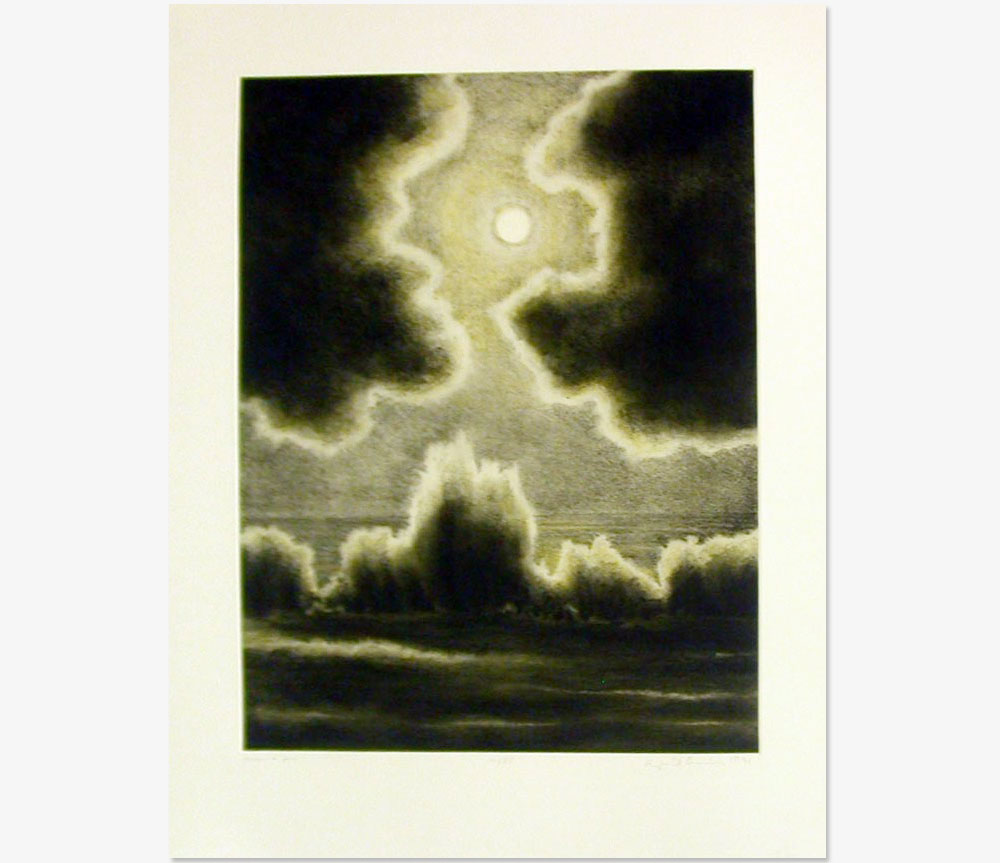
April Gornik
The Back of the Storm
(born 1953)
American 1985 Oil on canvas 82 ½ x 114 inches Museum purchase with funds provided by the James F. Dicke Family in honor of Marianne Lorenz, Assistant Director for Collections and Programs 1989–1999 1998.26 223
Weather Patterns
How can you capture clouds? If they slip through your fingers, will they slip through a brush? Look closer at April Gornik’s The Back of the Storm and see not only how nature becomes art, but also how art can enhance your experience of nature.
A Day in the Life
Tools and Techniques
Behind the Scenes
Look Closer
Signs & Symbols
Dig Deeper
Scaling the Sublime
Gornik’s paintings tap into the tradition of the sublime in landscape painting. Popular in the eighteenth and nineteenth centuries, the sublime denoted a unique encounter with the size and power of nature that overwhelmed the viewer. Such an encounter evoked feelings such as awe, transcendence, or fear. One example of a painting in The DAI’s collection that expresses this sensibility is William Haseltine’s Porto Venere, Spezia, Italy in Gallery 207.

William Stanley Haseltine (American, 1835–1900), Porto Venere, Spezia, Italy, 1878, oil on canvas, 32 ½ x 56 inches. Museum purchase with funds provided by Virginia Rike Haswell by exchange, 2000.15.
However, the scale of the paintings is different. Almost seven-feet high and ten-feet wide, Gornik’s painting envelopes the viewer, filling one’s entire field of vision. Indeed, the significance of scale—whether small or large—is why Gornik insists that paintings must be experienced in person, rather than just seen on a screen.
Poll
Considering the scale along with the use of color and line, how would you describe The Back of the Storm?
Arts Intersected
Cloudy Judgment
Gornik paints much of her work in oil while also producing many drawings and prints. These also depict nature, yet enable her to create different effects. For example, here is a print by Gornik in The DAI’s collection, entitled Moon and Sea. It is made with two kinds of etching techniques, soft ground and spit bite.

April Gornik (American, born 1953), Moon and Sea, 1991, [two plate] soft ground and spit bite etching in colors, edition 10/35, plate: 23 1/8 x 18 1/8 inches, sheet: 29 1/2 x 23 5/16 inches. Museum purchase with funds provided by James F. Dicke Family, 1997.9.
Both The Back of the Storm and Moon and Sea contain dramatic clouds, but are they the same? Clouds in nature can take on seemingly infinite shapes, shades, and textures. Consider how the two mediums—paint and print—enable you to experience the varied qualities of clouds in different ways.
The Sculpture Speaks
Did You Know?
Expert Opinion
Look Around
About the Artist
Second Nature
For over three decades April Gornik has explored the diversity of the natural world and how it changes when translated through the artist’s vision and hand into two-dimensional images. Her paintings are recognizable scenes, but they are hardly photographic; rather, they often blur into abstraction. How did she become fascinated by nature? What is her process for creating such paintings? Watch this video to learn more.
Used with permission from Eben Hall.
Transcript:
April Gornik:
I remember the first landscape that I made vividly, because, in fact, I wasn’t planning on it. I had been making these sculpture-like objects that had metal glued onto them, and I was thinking of other ways of evoking light, and an image popped into my head. When I assembled everything and stood back, I realized that I had just made a landscape. My initial reaction was, “Uh-oh, a landscape. This isn’t really what I was supposed to be doing to be in the contemporary art world.” But I just kept going with it, because I was actually really excited about having somehow captured light on a flat surface. It seemed to me at the time that I invented painting for myself.
The way I began working with landscapes was strictly out of my imagination. Then I quickly decided that that was a good thing, because it was like poetry and inventive, and that if I worked from photographs that would be like cheating. I went to the American Southwest a few years after I had begun painting landscapes, and I had a camera with me. When I saw the landscape out there it so blew my mind that, as I was taking photographs, I realized that I couldn’t have made this up. So it was kind of a challenge to start seeing how I could work with a photograph.
It’s typical of the painting process that I’ll start with something that seems utterly clear, and within just a week or two I’ll find that I’m off in some direction that I didn’t anticipate—that’s sometimes radically and sometimes only slightly—but in every case always something that’s not controllable, and is not able to be determined before I begin the painting. So the process of painting always takes me in another direction.
When I make compositions for paintings, I like to subtly emphasize certain abstract elements. It could be a kind of tension that exists in the composition; it could be a kind of exaggeration or pushing of the color in a certain direction, so that it’s just one side or the other of actual natural representation, so that there’s a little edge of surreality or formalism or abstraction or—you know you could describe it in various different ways. But it’s just a way of pushing the viewer so they’ll see what I’m doing in a way that I hope evokes a slightly more emotional reaction than just, “I’m looking at a picture of a landscape.”
I really have never come up with a good catchall description for the way that I abstract nature. I don’t really have a particular way of being able to summarize it as a genre; it would be convenient! When we were traveling around recently, my friend said, “That’s such a Gornikian landscape,” and I thought, “Do I like the sound of that?” [Laughs]
Talk Back
Nature is a Painting
It is often said that art imitates nature. But can nature imitate art? Can art make us see nature in a new way? If so, how?

